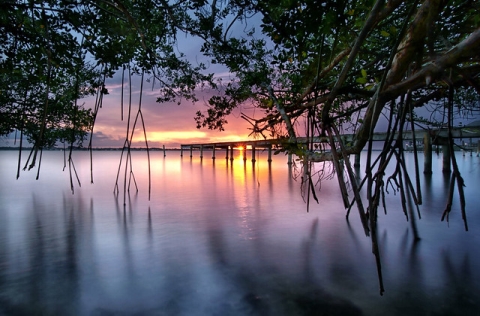Habitat
The Indian River Estuary is the most bio-diverse habitat in North America.
About
The Indian River Lagoon National Estuary has more species of animals and plants than any other estuary in North America, including over 2,200 animal species and over 2,100 plant species. Because the Indian River Lagoon Estuary is located where temperate and tropical zones overlap and it's brackish water is fed by fresh and salt water sources, it is uniquely situated to support a wide variety of resident and migratory plants and animals.
Habitat
Seagrass
Some of the most extensive seagrass beds of the estuary, including manatee grass, turtle grass, shoal grass and the endangered Johnson's seagrass are only found in the Indian River Lagoon. These seagrass communities provide spawning, nursery, and foraging habitat for many aquatic species, including spotted sea trout, redfish, snook, tarpon, mullet, sheepshead, pompano, seahorses, blue crabs, hermit crabs, pink shrimp, scallops, clams, marine worms, marine snails, and other crustaceans. Manatees, dolphins, otters and juvenile sea turtles are commonly found foraging in the estuary's seagrass.
Oyster Bars
Oyster bars, made up of the filter-feeding mollusks, help cleanse the estuary and stabilize shorelines. They also provide habitat for the fry, shrimp, mollusks and crustaceans that support the estuary's shorebirds and waterfowl.
Salt Marshes
Salt marshes with their associated tidal creeks and mud flats consist of such marsh plants as smooth cordgrass, saltgrass, saltwort and glasswort. Salt marshes also provide abundant food and cover for a wide variety of resident and transient wildlife, including alligators, snakes, marsh rabbits, waterfowl, shore birds and crustaceans.
Mangroves
The estuary's mangrove habitats include three true species of mangrove trees. These trees play a vital role in the food chain of the Indian River Estuary and also in the growth and development of many aquatic organisms. Microorganisms, which feed on decaying mangrove leaves, become food for shrimp, crabs, snails, and worms. They in turn become food for many species of fish, which in turn, support numerous wading birds in the refuge.
Mangrove trees contain several different communities of life from their roots to their canopy. The distinctive roots of the mangroves provide habitat for oysters and barnacles and sheltering habitat for many species of juvenile fish. The trunk and branches of the tree provide habitat for periwinkle snails, mangrove crabs, and mangrove snakes. The tree canopies provide nesting habitat for many species of birds.



